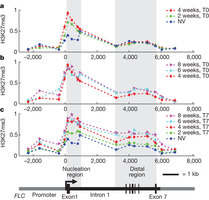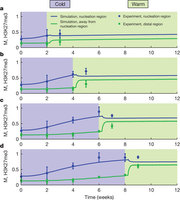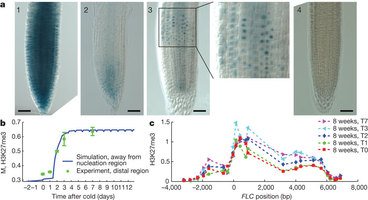摘要:“春化作用”(植物感知和保持一个使其能够在春天发芽或开花的冬天记忆的过程)是一个经典的表观遗传(后生)过程。在拟南芥中,它涉及在寒冷时期对开花抑制因子FLC的基于Polycomb的沉默作用。FLC在温度回升时产生稳定的沉默作用。研究人员将数学模拟和实验结合起来,建立一个关于FLC在“春化作用”中所起作用的定量模型。在寒冷天气产生的Polycomb沉默作用的一个严格局部化的成核区域,似乎足以在气温回暖后切换FLC位点的表观遗传状态,其中量化的沉默是由切换到沉默状态的那部分细胞实现的。
生物探索推荐英文论文摘要:
Nature 476, 105–108 (04 August 2011)
Doi:10.1038/nature10241
A Polycomb-based switch underlying quantitative epigenetic memory
Abstract:
The conserved Polycomb repressive complex 2 (PRC2) generates trimethylation of histone 3 lysine 27 (H3K27me3), a modification associated with stable epigenetic silencing. Much is known about PRC2-induced silencing but key questions remain concerning its nucleation and stability. Vernalization, the perception and memory of winter in plants, is a classic epigenetic process that, in Arabidopsis, involves PRC2-based silencing of the floral repressor FLC. The slow dynamics of vernalization, taking place over weeks in the cold, generate a level of stable silencing ofFLC in the subsequent warm that depends quantitatively on the length of the prior cold. These features make vernalization an ideal experimental system to investigate both the maintenance of epigenetic states and the switching between them. Here, using mathematical modelling, chromatin immunoprecipitation and an FLC:GUS reporter assay, we show that the quantitative nature of vernalization is generated by H3K27me3-mediated FLCsilencing in the warm in a subpopulation of cells whose number depends on the length of the prior cold. During the cold, H3K27me3 levels progressively increase at a tightly localized nucleation region within FLC. At the end of the cold, numerical simulations predict that such a nucleation region is capable of switching the bistable epigenetic state of an individual locus, with the probability of overall FLC coverage by silencing H3K27me3 marks depending on the length of cold exposure. Thus, the model predicts a bistable pattern ofFLC gene expression in individual cells, a prediction we verify using the FLC:GUS reporter system. Our proposed switching mechanism, involving the local nucleation of an opposing histone modification, is likely to be widely relevant in epigenetic reprogramming.

Figure 1: H3K27me3 ChIP experiments.

Figure 2: Schematic outline of mathematical model for FLC silencing.

Figure 3: Fitting model output to experimental ChIP data.

Figure 4: Validating model predictions.







